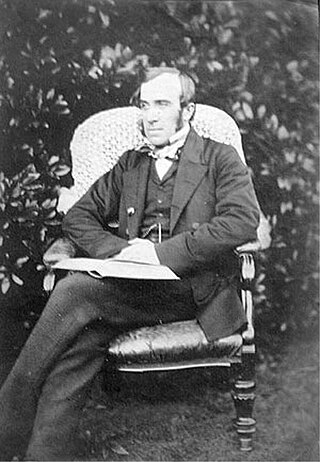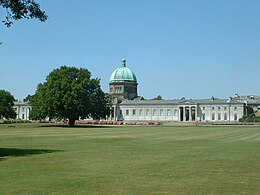Edward Backhouse Eastwick CB was an English orientalist, diplomat and Conservative Member of Parliament. He wrote and edited a number of books on South Asian countries. These included a Sindhi vocabulary and a grammar of the Hindustani language.

Sir Monier Monier-Williams was a British scholar who was the second Boden Professor of Sanskrit at Oxford University, England. He studied, documented and taught Asian languages, especially Sanskrit, Persian and Hindustani.

Edward Byles Cowell, was a noted translator of Persian poetry and the first professor of Sanskrit at Cambridge University.
Fort William College was an academy of oriental studies and a centre of learning, founded on 18 August 1800 by Lord Wellesley, then Governor-General of British India, located within the Fort William complex in Calcutta. Wellesley started the Fort William College to train the European administrators. He backdated the statute of foundation to 4 May 1800, to commemorate the first anniversary of his victory over Tipu Sultan at Seringapatam. Thousands of books were translated from Sanskrit, Arabic, Persian, Bengali, Hindi, and Urdu into English at this institution.
Francis Johnson was a British linguist.

The East India Company Military Seminary was a British military academy at Addiscombe, Surrey, in what is now the London Borough of Croydon. It opened in 1809 and closed in 1861. Its purpose was to train young officers to serve in the East India Company's own army in India.

Thomas Medland was an English engraver and draughtsman. He was drawing-master at Haileybury College and exhibited at the Royal Academy. He illustrated numerous works during his lifetime and was landscape engraver to the Prince of Wales.
Alexander Hamilton (1762–1824) was a British linguist who was one of the first Europeans to study the Sanskrit language. He taught the language to most of the earliest European scholars of Indo-European linguistics. He became the first professor of Sanskrit in Europe.

The position of Boden Professor of Sanskrit at the University of Oxford was established in 1832 with money bequeathed to the university by Lieutenant Colonel Joseph Boden, a retired soldier in the service of the East India Company. He wished the university to establish a Sanskrit professorship to assist in the conversion of the people of British India to Christianity, and his bequest was also used to fund scholarships in Sanskrit at Oxford. The first two professors were elected by Oxford graduates, as the university's statutes provided: Horace Hayman Wilson won by a narrow majority in 1832, and the 1860 election was hotly contested, as the rivals each claimed to be best at fulfilling Boden's intentions and presented different views about the nature and purpose of Sanskrit scholarship. Reforms of Oxford implemented in 1882 removed all mention of Boden's original purpose from the statutes, removed the power to elect the professor from graduates, and gave the holder of the professorship a fellowship at Balliol College, Oxford.
Sir Graves Chamney Haughton FRS was a British scholar of Oriental languages.

The election in 1860 for the position of Boden Professor of Sanskrit at the University of Oxford was a competition between two candidates offering different approaches to Sanskrit scholarship. One was Monier Williams, an Oxford-educated Englishman who had spent 14 years teaching Sanskrit to those preparing to work in British India for the East India Company. The other, Max Müller, was a German-born lecturer at Oxford specialising in comparative philology, the science of language. He had spent many years working on an edition of the Rig Veda and had gained an international reputation for his scholarship. Williams, in contrast, worked on later material and had little time for the "continental" school of Sanskrit scholarship that Müller exemplified. Williams regarded the study of Sanskrit as a means to an end, namely the conversion of India to Christianity. In Müller's opinion, his own work, while it would assist missionaries, was also valuable as an end in itself.
Charles Stewart (1764–1837), was a British orientalist who served in the Bengal Army from 1781 until 1808. He was assistant-professor of Persian at Fort William College, Calcutta from 1800 until 1806, while from 1807 until 1827, he was professor of Arabic, Persian, and Hindustani language at the East India College in Haileybury, India. During this time, he edited and translated oriental works.
George Hadley was an English army officer of the East India Company, now known as an orientalist for his early work on Hindustani.
Henry George Keene was an English employee of the East India Company, as soldier, civil servant, and orientalist. He was known as a Persian scholar, and also was a churchman and academic.
Evangelical chaplains in India were a significant group of Anglican clergy around the year 1800, employed by the East India Company, especially in the Bengal presidency. They were not missionaries, but ministered to the British population. On the other hand, they tried to facilitate missionary activity in line with their evangelical Christian views.
Arthur Gray Butler (1831–1909) was an English academic and cleric, the first headmaster of Haileybury College.
Thomas Roebuck (1781–1819) was a Scottish army officer of the East India Company, known as an orientalist and lexicographer.
Arthur Henry Bleeck (1829–1877) was a British orientalist. He was born on 18 May 1829 in Westbury, Wiltshire, the son of William Bleeck (1801/2–1873), who was from 1830 rector of Huish, Wiltshire, and his wife, Charlotte, née Goodman.

Claudius James Erskine, known as Claude Erskine ICS, was a British Indian civil servant, judge and vice-chancellor of the University of Calcutta.





